模拟联合国 经济事务司共18页
- 格式:ppt
- 大小:3.34 MB
- 文档页数:18
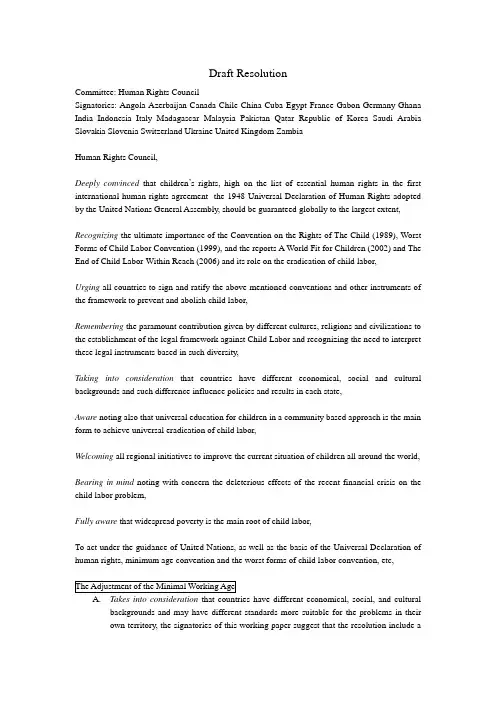
Draft ResolutionCommittee: Human Rights CouncilSignatories: Angola Azerbaijan Canada Chile China Cuba Egypt France Gabon Germany Ghana India Indonesia Italy Madagascar Malaysia Pakistan Qatar Republic of Korea Saudi Arabia Slovakia Slovenia Switzerland Ukraine United Kingdom ZambiaHuman Rights Council,Deeply convinced that children’s rights, high on the list of essential human rights in the first international human rights agreement- the 1948 Universal Declaration of Human Rights adopted by the United Nations General Assembly, should be guaranteed globally to the largest extent,Recognizing the ultimate importance of the Convention on the Rights of The Child (1989), Worst Forms of Child Labor Convention (1999), and the reports A World Fit for Children (2002) and The End of Child Labor-Within Reach (2006) and its role on the eradication of child labor,Urging all countries to sign and ratify the above mentioned conventions and other instruments of the framework to prevent and abolish child labor,Remembering the paramount contribution given by different cultures, religions and civilizations to the establishment of the legal framework against Child Labor and recognizing the need to interpret these legal instruments based in such diversity,Taking into consideration that countries have different economical, social and cultural backgrounds and such difference influence policies and results in each state,Aware noting also that universal education for children in a community based approach is the main form to achieve universal eradication of child labor,Welcoming all regional initiatives to improve the current situation of children all around the world,Bearing in mind noting with concern the deleterious effects of the recent financial crisis on the child labor problem,Fully aware that widespread poverty is the main root of child labor,To act under the guidance of United Nations, as well as the basis of the Universal Declaration of human rights, minimum age convention and the worst forms of child labor convention, etc,A.Takes into consideration that countries have different economical, social, and culturalbackgrounds and may have different standards more suitable for the problems in theirown territory, the signatories of this working paper suggest that the resolution include aclause reminding the paramount role of national response to child labor and the respectfor states sovereignty;B.Advocates the creation of specific minimum working age standards instead of auniversal one;C.Proposes to divide countries in different categories and international organizationsshould play a more important role to supervise the child labor issue world wide; And theMinimum Age Convention No;138 which was adopted in 1973 should also be taken asreference;D.Decides to make different standards accordingly to the different forms of child labor;For the worst forms of child labor, as mentioned in the Convention No;182, we shouldset the age standard as is the adult’s age according to the nation’s law; And then for theless severe forms such as manufacturing and farming, Fully believing that the specificages various from different countries and regions, standard cannot only be the numbers,however there is a common sense that the 20 year old can be the upper limit; Andcombining the fact that the children( under 20 ) is overburdened by the heavy work,there will be a objective definition of the child labor age;E. Recommends establishing the definition formula :the work is fit for the child of the age<fact age≤the work is do harm for the children’s physical and mental health;that widespread poverty is the main root of child labor and that the entire world faces one of its most intense economical crisis that may affect millions of children, the signatories recommended that the resolution should include clauses that drawattention of countries and international organizations to the current crisis’ impact on theissue of child labor:economy might have on fragile economies and as a consequence the risk of worseningthe child labor problem,B.recommend that the most developed countries reiterate their commitment tointernational funds, financial aid and child labor abolition projects in order to avoidfurther deterioration on the conditions of children all over the world, especially on theleast developed countries,C.further proclaim the necessity to maintain worldwide awareness programs against childlabor and the fundamental role played by children's rights,D.calls upon all states to turn the commitments into concrete actions , gradually andeffectively eliminating child labor that jeopardize the children physical mental andspiritual health, their education;7. Insists that the elimination of child labor can’t be achieved without a proper financial help from developed countries, the signatories propose to set a new loan section called “CLEOL”(child labor elimination-oriented loan):A.The function of this section is to lend low-interest money to the countries suffering childlabor,B.The fund should be run under the management of UNICEF and the supervision of UNsupervising body; The money comes from developed countries donated by a certainproportion of its GDP annually,C.The amount of money one country can borrow from this loan should be directedconnected with the country’s child labor elimination; What’s more, a certain proportionof the money one country borrow should be invested on education with the rest of themoney being used by the country’s will,D.The reduction of child labor of a country will be measured by human right council’sannual report;8. Decides to tackle poverty, and creating decent work for adults;9. Recommends to support the Fund "Class of 2015: Education for All", in order to provide more children in poverty chances to continue their education;10. Proclaims that strengthening the supervision on child labour using of the multi-national companies is more than necessary:A.recommend that the multi-national cooperations should comply to the domestic lawsprudently,B.recommend that the third party organisations should take special investigation on thelabour using status on multi-national cooperations,C.recommend governments to set up more effective and harsh laws and regulations torestrict the multi-national cooperations to use child labour,D.recommend to provide subsidies and tax cutting policies for the cooperations whicheradicate the child labour using in their manufacture;11. Decides to establish clear stipulations for countries giving out and receiving donations or programs stand by the comprehensive funding system, which are:A.emphasize countries giving their donations should have promised on non-violations onstates sovereignty and obey related laws in the international society,B.emphasize countries receiving donations are those insufficient in facilities and economyand lacking of national law structures;12. Proclaims the entities of supervisions on use of donations go to international organizations rather than local governments;child labor's conditions, safety standards and basic rights, the global union movement is calling for additional regulation of international trading laws as well as proper supervision on run of multinational corporations, including the following suggestions:A.set up the rules of world trade overseen and enforced by the World Trade Organization(WTO) should include some rules stipulating the banning of child labor,B.prohibit trafficking or sale of girls and women for sexual exploitation, sexual abuse oreven transplantation of organs which inhumanly violate the basic rights of the victimsare forbidden and deserves strict punishment,C.recommend organizations like ILO get more data and statistics in those “hidden” areassuch as domestic servants, on farms or with home-based out-workers on child labors,D.suggest media be given more inspective and supervisory legitimacy to do its job inrevealing situations on trafficking, sexual exploitation and other illicit use of child laborwhich also can stimulate related departments to solve them under such public pressure,E.require that National laws or regulations or the competent authority shall prescribe theregisters or other documents which shall be kept and made available by the employer;such registers or documents shall contain the names and ages or dates of birth, dulycertified wherever possible, of persons whom he employs or who work for him and whoare less than 18 years of age,F.call on campaigns on specific industries,G.recommend accounting for the fact that it's hard to take on the whole global economy,so just work industry by industry; People suffering in those industries can unit to maketheir voice heard to the employers of MNCs and improve working conditions orpayments;14. Proclaims that improvement in the educational system, such as universal education for all children, has considerably diminished the child labor in countries that adopted such policies, the Human Rights Council should highly encourage the adoption of such policies;Education of parents:A.Recognizes the principle that both parents have common responsibilities for theupbringing and development of the child, while change attitude of viewing towardsgender;B.Requires that render appropriate assistance to parents and legal guardians in theperformance of their child-rearing responsibilities and ensure the development ofinstitutions, facilities and services for the care of children;C.Requests enhancement of parents’ specific training that will provide the poor with someworking skills; In this way, the poor country can create advanced methods of operation,deploying human resources in a reasonable way, setting up efficient organization andenhancing management of work force of fixed number and therefore productionefficiency of work force is increased;Education of the young15. Recommends that primary education should be free, compulsory, well-resourced, relevant and nearby; In fact, it is much easier to monitor school attendance than to inspect factories and workshops;16. Reiterates the right of accessing the equal education should be guaranteed for both boys and girls;17. Encourages the development of different forms of secondary education, including general and vocational education, make them available and accessible to every child, and take appropriate measures such as the introduction of free education and offering financial assistance in case of need18. Calls upon setting up special funds for education to be used mainly for assisting outlying and poverty-stricken areas and areas inhabited by minority ethnic groups in enforcing compulsory education there;19. Recommends carrying out extensive social mobilization to play the roles of non-governmental organizations, communities, and the mass media under the guidance of UN and UNICEF to improve the education and medical training standard;20. Advocates exchange programs on technology and social science between developed and developing countries, which can not only give the children in poor countries more and better opportunities to gain knowledge and training skills but also urge great power to send more volunteers and technology in the poor areas;21. Decides to arm the children with consciousness of law and self-protection such as requiring education and paying so that they can defend themselves such as delivering their plea in the form of a petition to U;N;22. Recommends providing programs aiming at equipping adults from countries, such as those in Africa, where children are traditionally regarded as the main economic source of the family, with practical skills for a particular job in order to get their own jobs to support the family in place of their children;23. Calls for documenting and evaluating all government and non-government programmes that are aiming at preventing, reducing and eliminating economic exploitation and violence against children for their effectiveness, publicise the findings and establish a clear set of criteria for “good practice”;24. Calls for special Education and training for females——girls and womenA.strongly recommend the recognition of the rights of potential victims of sexualexploitation, such as but not limited to:B.recommend raising their ideological and moral standards of basic human rights;Especially the right to personal dignity facing with sexual exploitation,C.recommend setting up special school for training of females to help them become bettereducated and acquire more legal, moral and cultural awareness and working skills,D.proclaim the right to seek all kinds of counsel including demonstration and mentalcompensations as seen fit in national law,E.proclaim the right to pursue information and justified approach to protect their own legalrights;Education of the public25. Aims at reaching a broad social consensus among people in which everyone:A.raise awareness of hazardous situation of child labor and form an atmosphere of publicsupervision and report to help the media protect fighting for the rights of child labor,B.pay more attention to the rights of child labor in order to help protect and guaranteethem,C.enhance sense of law and concept of rule by law,D.Emphasize the need for negotiation of gender equality in the basic infrastructuralbuilding by promoting initiatives in conflict resolutions, as well as to implementmechanisms on peace agreements;26. Recommends proposing mutual-beneficial programs, in which the developed countries will have the advantage of employing elites from all over the world working for them, and the developing countries can improve both the quality of their compulsory education and their citizens:A.recommend launching the program is called OEP(Overseas Education Project);Thedeveloped countries are supposed to come to the aid since the elementary education inthe Third World; The aids shall cover the aspects of exchanging students and teachers,infrastructure and teaching methods; In high schools or universities, those countries willchoose their best students to have further studies in the developed countries; They maystay abroad or return to their motherlands after graduation;27. Requests handle of large scale of desolation caused by child labor by utilizing the following methods for rehabilitation and social integration:A.create and support medical facilities available for testing on sexually transmitteddiseases and surgeries accidental injuries in working in the form of temporary short termemergency clinics for fast and immediate victims services,B.add training in judiciary, police, religious leaders on repercussions of trafficking andsale children for sexual services and how to assist victims,C.develop incentives for attorneys to defend victims of trafficking and child labor,D.demand repercussions and disciplinary acts for those who commit trafficking and childlabor,E.support economic livelihood for victims such as primary technological training andsupport empowerment of females such as to create easily outreach programs in order tocreate a safe environment for victims to report and recover form sufferings;28. Welcomes the establishment of an international oversight mechanism which focus on:A.recommend the assessment and supervision of the behavior of multinationalcorporations with the report launching to public to discourage them from abusing childlabor,B.call for the oversight of financial flow of international aiding funds to ensure that thefunds could be used properly and effectively;29. Urges the collaboration of international society in the mechanism with the following objects achieved:A.recommend a Coordinating Committee, including ILO and UNICEF, could be set up tocoordinate the oversight work in the mechanism;,B.recommend strengthening the leading role of the UN should be guaranteed as UNprovides the general standards and practical paradigm; Special inspectors would be sentby UN to different regions to deliver periodic feedback reports;30. Further recommends ratifying and implementing ILO Convention n; 138 on the minimum age of work and the ILO Convention n; 182 on the worst forms of child labor;31. Further proclaims the importance to ensure that national legislation is harmonised with international child labour standards, articulate mandates and measures for their full implementation, monitor law enforcement especially with regard to the elimination of the worst forms of child labour (as per ILO 182) –provide for periodic progress reporting and make findings available to the public in general;32. Decides to develop comprehensive training programs for the judiciary on child sensitive approaches to handling childr en’s complaints and testimonies;33. Welcomes the establishment of an international oversight mechanism which focus on:carry out assessment and supervision of the behavior of multinational corporations with the report launching to public to discourage them from abusing child labor:A.establish monitoring of the enforcement of domestic laws and international conventions,B.establish the oversight of financial flow of international aiding funds to ensure that thefunds could be used properly and effectively;34. Urges the collaboration of international society in the mechanism with the following objects achieved:A.recommend a Coordinating Mechanism, connecting ILO and UNICEF, plus theinternational non-governmental organization, could be set up to coordinate the oversight work in the mechanism,B.recommend the leading role of the UN should be guaranteed as UN provides the generalstandards and practical paradigm, special inspectors would be sent by UN to different regions to deliver periodic feedback reports,C.recommend NGOs act as important supplement, and they should also conduct specificassessment and supervision and submit their reports to make up the part that may be neglected;35. Decides to act the following measures to strengthen Border Surveillance:A.develop and implement common tools and applications for border surveillance at EUlevel:B.research and development to improve the performance of surveillance tools,mon application of surveillance tools,mon pre-frontier intelligence picture;36. Recommends interlinking and streamlining existing surveillance systems and mechanisms at Member States level:A.provide the essential border surveillance infrastructure at national level,B.set up communication network between the national coordination centres,C.support to neighbouring third countries for the setting up of border surveillanceinfrastructure;37. Recommends establishing creation of a common monitoring and information sharing environment for the EU maritime domain:A.set up integrated network of reporting and surveillance systems for border control andinternal,B.set up security purposes covering the Mediterranean Sea, the southern Atlantic Oceanand the Black Sea,C.set up integrated network of reporting and surveillance systems for the whole EUmaritime domain;38. Decides to establish a coordinating body to monitor trends and the impact of violence on children and handle/monitor complaints from children victims of violence in the workplace;39. Decides to improve research methodology and involve children to reveal all hidden forms of violence against children in the work place, especially in domestic work, on family farms and enterprises and in the tourist industry;40. Decides to document and evaluate all government and non-government programmes that are aiming at preventing, reducing and eliminating economic exploitation and violence against children for their effectiveness, publicise the findings and establish a clear set of criteria for “goodpractice”;41. Uses the Concluding Observations of the CRC Committee as benchmarks for performance and publish a “barometer” report;42. Decides to review national and regional child labour laws to address violence and sexual abuse in the workplace, including domestic child work;43. Decides to take adequate legislative measures to ensure the explicit prohibition of sexual exploitation and abuse of children under criminal law;44. Proclaims that child victims of sexual exploitation and abuse are not criminalized or penalized;45. Implements appropriate policies and programmes for the prevention, recovery and social reintegration of child victims, in accordance with the Declaration and Agenda for Action and the Global Commitment adopted at the 1996 and 2001 World Congresses against Commercial Sexual Exploitation of Children;46. Urges to carry out gender awareness campaigns to combat sexual exploitation;47. Recommends carrying out policy responses to address the causes of child labour, paying particular attention to the situation of girls;48. Decides to make immediate actions to tackle the worst forms of child labour;49. Recommends paying greater attention to the education and skills training needs of adolescent girls - a key action point in tackling child labour and providing a pathway for girls to gain Decent Work as adults;。
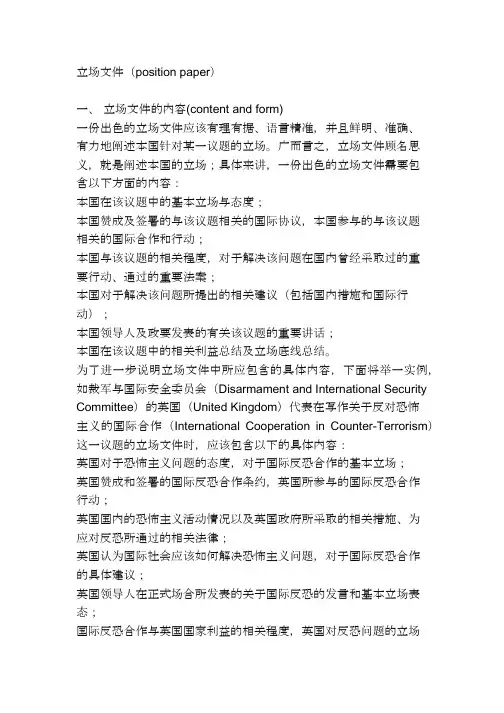
立场文件(position paper)一、立场文件的内容(content and form)一份出色的立场文件应该有理有据、语言精准,并且鲜明、准确、有力地阐述本国针对某一议题的立场。
广而言之,立场文件顾名思义,就是阐述本国的立场;具体来讲,一份出色的立场文件需要包含以下方面的内容:本国在该议题中的基本立场与态度;本国赞成及签署的与该议题相关的国际协议,本国参与的与该议题相关的国际合作和行动;本国与该议题的相关程度,对于解决该问题在国内曾经采取过的重要行动、通过的重要法案;本国对于解决该问题所提出的相关建议(包括国内措施和国际行动);本国领导人及政要发表的有关该议题的重要讲话;本国在该议题中的相关利益总结及立场底线总结。
为了进一步说明立场文件中所应包含的具体内容,下面将举一实例,如裁军与国际安全委员会(Disarmament and International Security Committee)的英国(United Kingdom)代表在写作关于反对恐怖主义的国际合作(International Cooperation in Counter-Terrorism)这一议题的立场文件时,应该包含以下的具体内容:英国对于恐怖主义问题的态度,对于国际反恐合作的基本立场;英国赞成和签署的国际反恐合作条约,英国所参与的国际反恐合作行动;英国国内的恐怖主义活动情况以及英国政府所采取的相关措施、为应对反恐所通过的相关法律;英国认为国际社会应该如何解决恐怖主义问题,对于国际反恐合作的具体建议;英国领导人在正式场合所发表的关于国际反恐的发言和基本立场表态;国际反恐合作与英国国家利益的相关程度,英国对反恐问题的立场底线。
二、立场文件的结构(structure)一般来讲,立场文件分为四个段落比较合理,分别为基本立场、国际行动、国内行动、解决方案。
采取这样的“四段式”文章结构,能够使立场文件观点明确、内容全面、环环相扣、逻辑清楚。
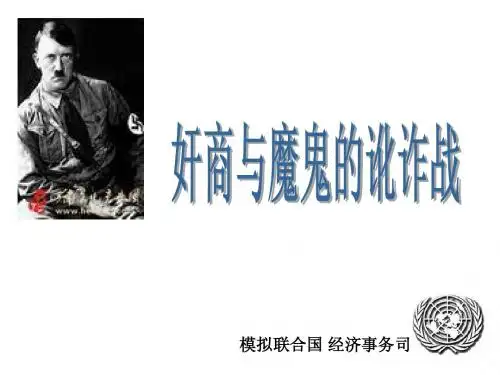
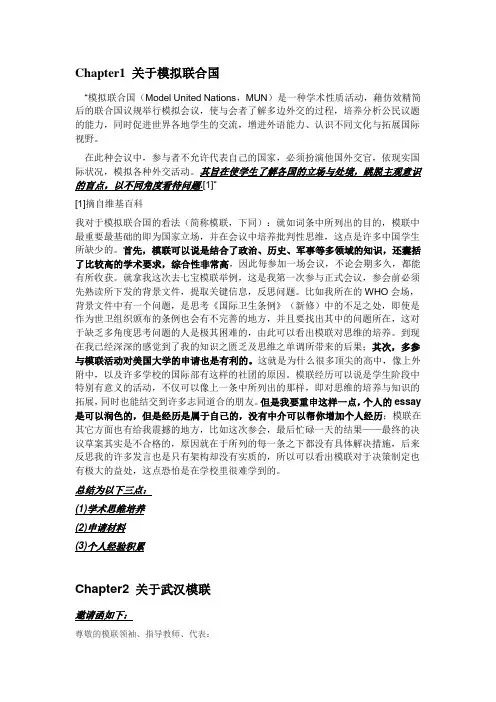
Chapter1 关于模拟联合国“模拟联合国(Model United Nations,MUN)是一种学术性质活动,藉仿效精简后的联合国议规举行模拟会议,使与会者了解多边外交的过程,培养分析公民议题的能力,同时促进世界各地学生的交流,增进外语能力、认识不同文化与拓展国际视野。
在此种会议中,参与者不允许代表自己的国家,必须扮演他国外交官,依现实国际状况,模拟各种外交活动。
其旨在使学生了解各国的立场与处境,跳脱主观意识的盲点,以不同角度看待问题.[1]”[1]摘自维基百科我对于模拟联合国的看法(简称模联,下同):就如词条中所列出的目的,模联中最重要最基础的即为国家立场,并在会议中培养批判性思维,这点是许多中国学生所缺少的。
首先,模联可以说是结合了政治、历史、军事等多领域的知识,还囊括了比较高的学术要求,综合性非常高,因此每参加一场会议,不论会期多久,都能有所收获。
就拿我这次去七宝模联举例,这是我第一次参与正式会议,参会前必须先熟读所下发的背景文件,提取关键信息,反思问题。
比如我所在的WHO会场,背景文件中有一个问题,是思考《国际卫生条例》(新修)中的不足之处,即使是作为世卫组织颁布的条例也会有不完善的地方,并且要找出其中的问题所在,这对于缺乏多角度思考问题的人是极其困难的,由此可以看出模联对思维的培养。
到现在我已经深深的感觉到了我的知识之匮乏及思维之单调所带来的后果;其次,多参与模联活动对美国大学的申请也是有利的。
这就是为什么很多顶尖的高中,像上外附中,以及许多学校的国际部有这样的社团的原因。
模联经历可以说是学生阶段中特别有意义的活动,不仅可以像上一条中所列出的那样,即对思维的培养与知识的拓展,同时也能结交到许多志同道合的朋友。
但是我要重申这样一点,个人的essay 是可以润色的,但是经历是属于自己的,没有中介可以帮你增加个人经历;模联在其它方面也有给我震撼的地方,比如这次参会,最后忙碌一天的结果——最终的决议草案其实是不合格的,原因就在于所列的每一条之下都没有具体解决措施,后来反思我的许多发言也是只有架构却没有实质的,所以可以看出模联对于决策制定也有极大的益处,这点恐怕是在学校里很难学到的。
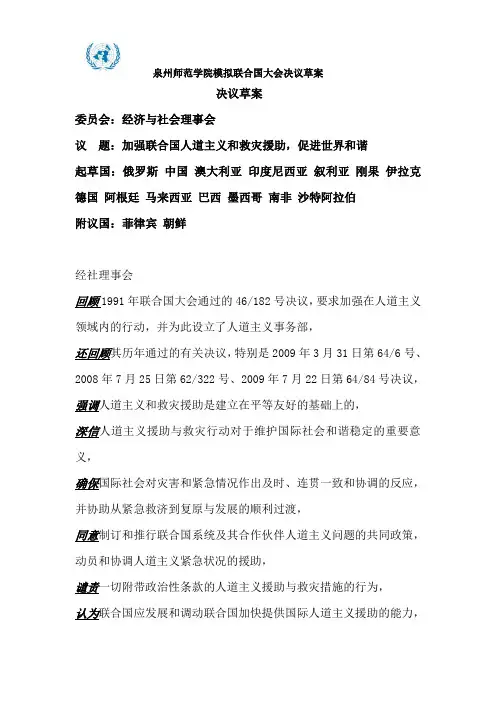
决议草案委员会:经济与社会理事会议题:加强联合国人道主义和救灾援助,促进世界和谐起草国:俄罗斯中国澳大利亚印度尼西亚叙利亚刚果伊拉克德国阿根廷马来西亚巴西墨西哥南非沙特阿拉伯附议国:菲律宾朝鲜经社理事会回顾1991年联合国大会通过的46/182号决议,要求加强在人道主义领域内的行动,并为此设立了人道主义事务部,还回顾其历年通过的有关决议,特别是2009年3月31日第64/6号、2008年7月25日第62/322号、2009年7月22日第64/84号决议,强调人道主义和救灾援助是建立在平等友好的基础上的,深信人道主义援助与救灾行动对于维护国际社会和谐稳定的重要意义,确保国际社会对灾害和紧急情况作出及时、连贯一致和协调的反应,并协助从紧急救济到复原与发展的顺利过渡,同意制订和推行联合国系统及其合作伙伴人道主义问题的共同政策,动员和协调人道主义紧急状况的援助,谴责一切附带政治性条款的人道主义援助与救灾措施的行为,认为联合国应发展和调动联合国加快提供国际人道主义援助的能力,促进减少灾害风险,宣传人道主义问题,提供紧急状况和自然灾害的及时信息,以促进全球人道主义援助,重申在复杂紧急情况和自然灾害局势中提供人道主义援助的所有行为体都应推动和充分遵守人道、中立、公正和独立的人道主义原则,欣见于2008 年6月3日至5日在罗马举行世界粮食保障问题高级别会议,并指出执行其结果,包括关于人道主义援助的内容,认识到紧急情况、恢复和发展之间的明确关系,并重申提供紧急援助的方式应迅速、有执行力并且有助于复兴和长期发展,以保证救济工作平稳地过渡为恢复和发展工作,注意到1949年的《日内瓦公约》及相关的1977年《附加议定书》以及2005年关于新增特殊标志的《第三附加议定书》所组成的“国际人道法”所做的呼吁:“无论是作为个人,还是通过政府或各种组织,我们都可以对遵守国际人道法做出重要贡献。
”承认近年来,由于经济危机、粮食危机、能源危机和气候变化等全球性问题,加之自然灾害频发、地区冲突不断,全球人道主义形势日益严峻,全球人道主义协调和反应能力面临严峻挑战;如何加强国际人道主义协调合作,切实帮助受灾国加强能力建设,实现从救灾向发展的顺利过渡,保持人道主义资源的可持续增长,促进世界和谐发展,是当前国际人道主义领域面临的最主要挑战,承认灾害是一个全球性问题。

模拟联合国第一篇:模拟联合国东北师范大学第五届模拟联合国大会简介一、什么是模拟联合国有那么一个学生活动,参与者都得正装出席,胸前别着证明代表身份的标志牌,在庄严的讲台上代表世界不同国家,为了各自国家的利益陈述立场、提出动议,或据理力争、或磋商结盟,直至针对某一议案投票表决……这就是模拟联合国。
模拟联合国(Model United Nations)简称MUN是模仿联合国及相关的国际机构,依据其运作方式和议事原则,围绕国际上热点问题召开的会议。
青年学生们扮演不同国家的外交官,作为各国代表,参与到“联合国会议”当中。
代表们遵循大会规则,在会议主席团的主持下,通过演讲阐述“自己国家”的观点,为了“自己国家”的利益进行辩论、游说,他们与友好的国家沟通协作,解决冲突;他们讨论决议草案,促进国际合作;他们在“联合国”的舞台上,充分发挥自己的才能。
这项活动起源于美国哈佛大学经过60多年的发展,模拟联合国活动现在已经风靡全世界,形式多样,规模不一,有国际大会、全国大会,还有地区级和校际间的大会,参与者有大学生到高中生,乃至初中生。
目前全世界每年有近四百个国际模拟联合国大会在五大洲的50多个国家召开。
每年参与大会的师生来自世界100多个国家,总人数超过四百万人。
模拟联合国活动之所以能够风靡全世界,是因为它是一项极富教育意义的活动。
为学生们带了更广阔的视野。
模拟联合国活动关注的问题广泛,大都是当今各国面临的热点问题,在这样一个充满激情和挑战的全球化时代,在我国改革开放继续深化,国际局势依然复杂多变的背景下,积极参与这项活动不仅有助于同学们对联合国的了解,更为同学们打开一扇窗,提供了一个舞台,让大家关心世界,用国际眼光来思考问题,讨论问题。
模拟联合国活动中主要涉及的话题: 和平与安全/恐怖主义/人权/ 环境/贫穷与发展/全球化/公共卫生等激发英语热情与培养学习能力。
由于模拟联合国活动源自西方,大部分会议的工作语言是英文。

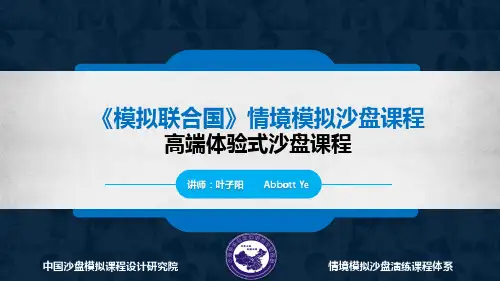
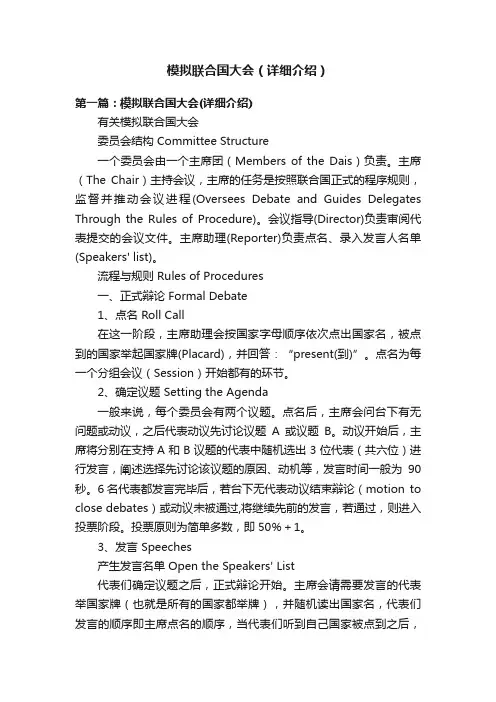
模拟联合国大会(详细介绍)第一篇:模拟联合国大会(详细介绍)有关模拟联合国大会委员会结构 Committee Structure一个委员会由一个主席团(Members of the Dais)负责。
主席(The Chair)主持会议,主席的任务是按照联合国正式的程序规则,监督并推动会议进程(Oversees Debate and Guides Delegates Through the Rules of Procedure)。
会议指导(Director)负责审阅代表提交的会议文件。
主席助理(Reporter)负责点名、录入发言人名单(Speakers' list)。
流程与规则 Rules of Procedures一、正式辩论 Formal Debate1、点名 Roll Call在这一阶段,主席助理会按国家字母顺序依次点出国家名,被点到的国家举起国家牌(Placard),并回答:“present(到)”。
点名为每一个分组会议(Session)开始都有的环节。
2、确定议题 Setting the Agenda一般来说,每个委员会有两个议题。
点名后,主席会问台下有无问题或动议,之后代表动议先讨论议题A或议题B。
动议开始后,主席将分别在支持A和B议题的代表中随机选出3位代表(共六位)进行发言,阐述选择先讨论该议题的原因、动机等,发言时间一般为90秒。
6名代表都发言完毕后,若台下无代表动议结束辩论(motion to close debates)或动议未被通过,将继续先前的发言,若通过,则进入投票阶段。
投票原则为简单多数,即50%+1。
3、发言 Speeches产生发言名单 Open the Speakers' List代表们确定议题之后,正式辩论开始。
主席会请需要发言的代表举国家牌(也就是所有的国家都举牌),并随机读出国家名,代表们发言的顺序即主席点名的顺序,当代表们听到自己国家被点到之后,便放下国家牌。

模拟联合国(MUN)简介(精选)第一篇:模拟联合国(MUN)简介(精选)模拟联合国(MUN)简介1.模拟联合国简介 1.1模联的成立在1947年的联合国大会上,成员国一致宣誓:(原文如下)...encourage the teaching of the United Nations Charter and the purposes and principles, the structure, background and activities of the United Nations in the schools and institutes of higher learning of their countries, with particular emphasis on such instruction in elementary and secondary schools.模联即为响应这一提议而创生。
这项活动在欧美已经拥有超过50年的历史,它是由世界各国官方和民间团体特意为青年人组织的活动。
模拟联合国活动发源于美国,自诞生至今,吸引了全球超过200,000名高中生和大学生,全世界每年举办近400个模拟联合国会议。
尽管“模拟联合国”在许多国家进行得如火如荼,但它一直到90年代中期才进入中国,北京大学、人民大学、外交学院、西安交通大学等高校在为这一活动的推广作着不懈的努力。
这项活动使中学生与联合国的形势紧密地联系起来,同时锻炼了其自身的领袖才能,对当今中国中学生的素质教育起着极为重要的作用。
中国作为联合国安理会常任理事国,有着尤为重要的国际责任。
而将成为未来领袖的中学生们,更应意识到肩上担负的使命。
1.2什么是模联?模联(MUN),即模拟联合国(Mode United States)的缩写,是组织学生模拟联合国某些工作的活动。
学生代表某个国家驻联合国大使,对该国的历史,政治,经济,社会文化等方面进行学习,按照类似联合国会议的规则和程序进行发言、游说、辩论、谈判,国家集团间达成共识,产生决议草案,并按照联合国的表决程序进行投票从而形成决议。
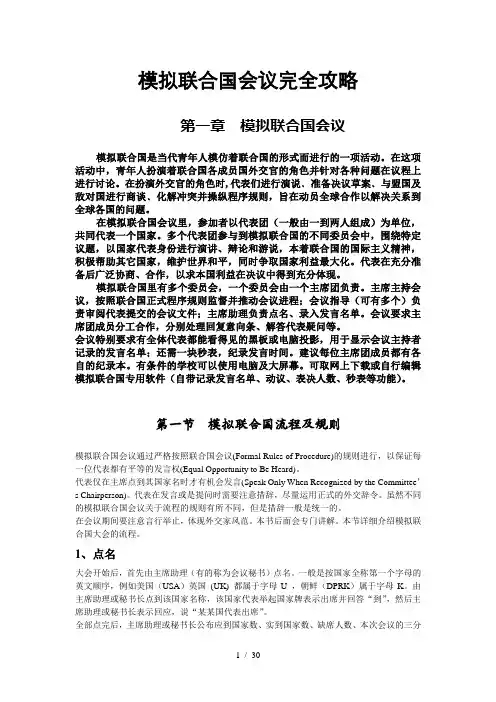
模拟联合国会议完全攻略第一章模拟联合国会议模拟联合国是当代青年人模仿着联合国的形式而进行的一项活动。
在这项活动中,青年人扮演着联合国各成员国外交官的角色并针对各种问题在议程上进行讨论。
在扮演外交官的角色时,代表们进行演说﹑准备决议草案﹑与盟国及敌对国进行商谈﹑化解冲突并操纵程序规则,旨在动员全球合作以解决关系到全球各国的问题。
在模拟联合国会议里,参加者以代表团(一般由一到两人组成)为单位,共同代表一个国家。
多个代表团参与到模拟联合国的不同委员会中,围绕特定议题,以国家代表身份进行演讲、辩论和游说,本着联合国的国际主义精神,积极帮助其它国家,维护世界和平,同时争取国家利益最大化。
代表在充分准备后广泛协商、合作,以求本国利益在决议中得到充分体现。
模拟联合国里有多个委员会,一个委员会由一个主席团负责。
主席主持会议,按照联合国正式程序规则监督并推动会议进程;会议指导(可有多个)负责审阅代表提交的会议文件;主席助理负责点名、录入发言名单。
会议要求主席团成员分工合作,分别处理回复意向条、解答代表疑问等。
会议特别要求有全体代表都能看得见的黑板或电脑投影,用于显示会议主持者记录的发言名单;还需一块秒表,纪录发言时间。
建议每位主席团成员都有各自的纪录本。
有条件的学校可以使用电脑及大屏幕。
可取网上下载或自行编辑模拟联合国专用软件(自带记录发言名单、动议、表决人数、秒表等功能)。
第一节模拟联合国流程及规则模拟联合国会议通过严格按照联合国会议(Formal Rules of Procedure)的规则进行,以保证每一位代表都有平等的发言权(Equal Opportunity to Be Heard)。
代表仅在主席点到其国家名时才有机会发言(Speak Only When Recognized by the Committee’s Chairperson)。
代表在发言或是提问时需要注意措辞,尽量运用正式的外交辞令。
虽然不同的模拟联合国会议关于流程的规则有所不同,但是措辞一般是统一的。
资料■名词解释:金砖国家(BRICS)最早是“金砖四国”(BRIC),由巴西(Brazil)、俄罗斯(Russia)、印度(India)、和中国(China)的英文首字母组成。
由于该词与英文的砖(Brick)类似,因此被称为“金砖四国”。
2010年12月,“金砖四国”一致商定,吸收南非(South Africa)为正式成员加入“金砖国家”合作机制,“金砖四国”变成“金砖五国”,并更名为“金砖国家”(BRICKS)。
(1)专家:金砖国家发展良好五大困难不容忽视中新网3月23日电中国国际经济交流中心举办的“金砖国家全球经济复苏的领跑者”高峰论坛在今日举办。
中国国际经济交流中心常务副理事长郑新立作了题为“新兴经济体经济现状、趋势和未来”的报告,宏观的阐述了金砖五国近些年来的发展和遇到的困境。
郑立新首先对金砖五国近几年的发展做了描述,他认为,金砖五国,现在以经济快速发展作为主要特点,已经展现在世界面前:五个国家的人口有28亿人,占全球人口的42%,人口增长率还是比较快的,2.36%。
国土面积占全国世界近30%。
金砖五国经济总量目前占到全球的18%,外贸总额占全球的15%,我们吸引的外资占到全球的53%,一半以上国际资本的流动都进到我们这五个国家来了。
郑立新详细阐述了从过去五年金砖国家GDP的增长率变化情况,并表示,五个国家增长态势都非常好,2009年、2010年由于受金融危机的影响,巴西和俄罗斯受的影响比较大一些,但是到2010年都恢复了增长的态势。
特别是印度的增长速度直逼中国,过去有个说法叫“龟兔赛跑”,现在这个说法不对了,是两匹马的赛跑,印度可能是一匹黑马,这匹黑马可能超过中国,中国稍不小心,增长速度就可能落在印度的后面,而且印度的经济增长比较均衡,增长的后劲我看比中国要大,所以我们要加把劲。
当说到金砖国家城市化率变化情况,郑立新表示,城市化率是金砖国家的最大潜力所在。
这几年中国的城市化率和印度城市化率的变化还是比较大的,根据中国的经验,每增加一个城市人口,需要增加的潜在基础设施和公共服务的投资需求就是10万块钱,一年增加1000万人,需要的基础设施和公共服务的潜在投资需求就是10万亿,一年增加2000万城市人口,潜在的投资需求就是20万亿。
议事规则与规则流程Rules of Order课程意义和目的•了解模拟联合国规则的内在逻辑(The Logic of MUN)•熟悉模拟联合国会议基本规则及流程(Basic Rules in MUN)•掌握模拟联合国会议规则中的专业术语(Professional Terms in MUN)•掌握规则流程使用技巧(Skills in Rules of Procedure)课程主要内容•解决一般问题的步骤与流程•模拟联合国规则流程及专业术语2一、会议成员1.主席团(Dais)u◆主席(Chair):主持会议;随时处理代表问题u◆会议指导(Director):观察会议,掌控会议方向、进程;审批文件u◆主席助理(Rapporteur):记录会议;负责点名、投票等环节2.代表(Delegate)u◆概念:一个国家派出参加会议的人,代表这个国家的形象与立场u◆职责:维护国家利益;展示国家形象;参与国际事务讨论u◆称呼:代表要牢记自己的身份,发言时的主语要用国家名,而不是“我”3.志愿者(Volunteer)u◆职责:负责传递意向条;负责相关会务,为代表提供方便二、解读模拟联合国会议规则流程1.点名(Roll Call)u◆点名的作用:确定到场国家总数,由此计算简单多数(1/2多数)和三分之二多数。
这些数据决定了表决通过的标准u◆点名的方式:主席助理按照国家名单上的顺序点名,点到的国家高举国家牌并答“到(Present) ”。
主席助理重复“某某国代表出席”,并在电脑屏幕上标示出席情况,最终计数2.设定议题(Setting the Agenda)u◆设定议题的条件:一个委员会同时有两个或两个以上的议题待讨论u◆设定议题的目的:确定多数国家感兴趣的议题为优先讨论的议题3.正式辩论(Formal Debate)u◆辩论的概念:不同于平时的辩论比赛,模联中的发言、磋商、游说等均被视为辩论u◆正式辩论:按照发言名单顺序进行的辩论叫正式辩论u◆发言名单(Speakers’ List)ü✓发言名单的产生:确定议题后,正式辩论开始。
模拟联合国大会总稿精彩纷呈,尽在“西南财经大学2008年模拟联合国大会”第一篇:模拟联合国大会总稿精彩纷呈,尽在“西南财经大学2008年模拟联合国大会”精彩纷呈,尽在“西南财经大学2008年模拟联合国大会” 2008年3月,西南财经大学在北京大学闭幕的第二届国际模拟联合国大会(Asian International United Nations)上成为中国地区获奖最多的学校,参赛学子载誉归来。
大赛之后,为选拔2009年模拟联合国西南财经代表队成员和系统推广模拟联合国活动,丰富同学们的文化生活,由共青团西南财经大学委员会主办,西南财经大学公共管理学院承办,西南财经大学模拟联合国团队提供技术协作的“西南财经大学2008年模拟联合国大会”随即启动。
宣讲会·启动仪式3月27日晚19:00,“西南财经大学2008年模拟联合国大会”宣讲会在经世楼G303正式展开。
出席此次宣讲会的有公共管理学院的副院长幸强国教授,学生工作部的杨海洋老师,语言文化学院的蒙华老师。
席间,蒙华老师对第二届国际模拟联合国赛事进行了介绍,幸强国教授更以流利的英文为大赛带来了祝福并正式启动了此次“西南财经大学2008年模拟联合国大会”。
在整个宣讲会的过程中,刚刚载誉而归的模拟联合国团队无疑是全场的焦点。
这个充满激情的团队热情地向在座的老师和同学介绍了模拟联合国大会的赛事流程,分享了他们参加大赛的经验,并通过现场模拟的方式让同学们加深了对模拟联合国大会各环节和两个主要委员会CERD(英文委员会)、HSC历史安全委员会(中文委员会)的了解。
现场气氛热烈,在阵阵欢笑声和鼓掌声中,两个多小时的宣讲会·启动仪式圆满落下帷幕。
现场同学跃跃欲试的神情,当场被派发完的报名表,让我们有理由相信模拟联合国这个大舞台会让西南财经大学的学子们展现他们最华美的一面。
报名3月28日——4月3日,“西南财经大学2008年模拟联合国大会”的报名活动全面铺开。
模拟联合国会议(流程)发言稿专题第一篇:模拟联合国会议(流程)发言稿专题模拟联合国会议(流程)发言稿Ladies and Gentlemen, My name is Ping Jiaxin, the Chair of today’s meeting.Welcome.I would like to introduce the members of the commission[kə'mɪʃ(ə)n].To my left, is the registrar ['redʒɪstrɑː].To my right , is the assistant of the chair.主席:各位代表,我是今天的会议主席平佳欣。
欢迎大家参加大会,在此对诸位代表的到来表示衷心的欢迎。
现在我将先介绍主席团成员。
在我左边的是会议指导,右边的是主席助理。
(主席助理和记录员的自我介绍)Now the assistant [ə'sɪst(ə)nt] will do the roll call.All delegates please raise your placard and say ‘present’ when your nation’s name is called.主席:下面进行点名。
被点到国家名的代表请举牌并答“到”。
(主席助理进行点名等)Today we will discuss the global[ˈɡləubəl] climate[ˈklaimit] and environmental problems.今天大会将对全球气候环境问题进行讨论。
Now the Speake rs’ List is open.Delegates, who want to be added ['ædɪd] in the Speakers’ List, please raise your placards.现在开启正式辩论发言名单,请希望被列入主发言名单的国家高举国家牌。